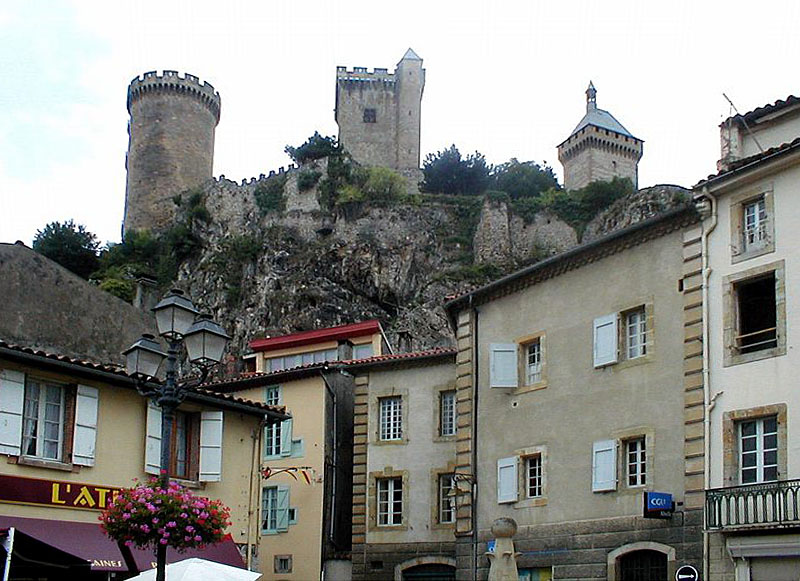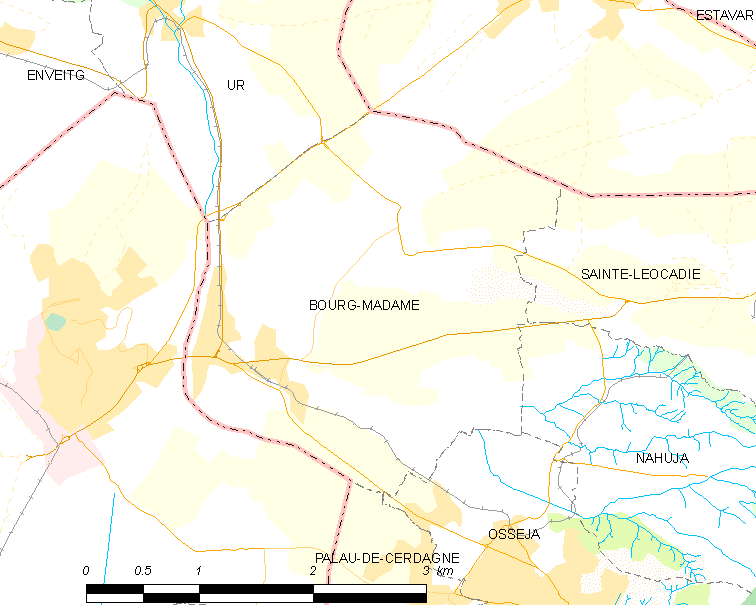|
Latour-de-Carol
Latour-de-Carol (; ca, La Tor de Querol) is a commune in the Pyrénées-Orientales department in southern France. Geography Localization Latour-de-Carol is located in the canton of Les Pyrénées catalanes and in the arrondissement of Prades. Transport The village's main claim to fame is as the site of the international railway station, Gare de Latour-de-Carol-Enveitg (). This station is the terminus of three lines, each with different gauges: * the Spanish state operator Renfe's gauge line running north from Barcelona via Ripoll * the French state operator SNCF's gauge line running south from Toulouse via Foix * SNCF's gauge line (known as the ''Yellow Train'') running west from Villefranche-de-Conflent As the French and Spanish tracks are different gauges, no trains run the whole way from Toulouse to Barcelona. Passengers have to change trains, which are however no longer scheduled to offer direct connections. Occasional freight-trains cross the border and are wo ... [...More Info...] [...Related Items...] OR: [Wikipedia] [Google] [Baidu] |
Gare De Latour-de-Carol-Enveitg
Latour-de-Carol-Enveitg (Catalan: La Tor de Querol-Enveig) or Latour-de-Carol is a railway station in Enveitg and Latour-de-Carol, Occitanie, France. It is the current terminus of three lines. France's SNCF operates TER (local) services on the Portet-Saint-Simon–Puigcerdà railway (from Toulouse-Matabiau) and on the Ligne de Cerdagne known as ''Train Jaune'' (from Villefranche-de-Conflent, with connections to Perpignan). Spain's Renfe Operadora runs Rodalies de Catalunya trains from L'Hospitalet de Llobregat on the Barcelona commuter rail line R3. SNCF also runs Intercités de Nuit night trains to Paris. Latour-de-Carol is one of the few stations in the world with three different gauges. Others include Montreux railway station, Hendaye station and Jenbach railway station, Madrid Atocha station(when the metro is included), Powell Street and Embarcadero stations in San Francisco, and several stations in Tokyo, mostly on the Toei Shinjuku Line. The line to Toulouse-Matabia ... [...More Info...] [...Related Items...] OR: [Wikipedia] [Google] [Baidu] |
Latour-de-Carol N20
Latour-de-Carol (; ca, La Tor de Querol) is a commune in the Pyrénées-Orientales department in southern France. Geography Localization Latour-de-Carol is located in the canton of Les Pyrénées catalanes and in the arrondissement of Prades. Transport The village's main claim to fame is as the site of the international railway station, Gare de Latour-de-Carol-Enveitg (). This station is the terminus of three lines, each with different gauges: * the Spanish state operator Renfe's gauge line running north from Barcelona via Ripoll * the French state operator SNCF's gauge line running south from Toulouse via Foix * SNCF's gauge line (known as the ''Yellow Train'') running west from Villefranche-de-Conflent As the French and Spanish tracks are different gauges, no trains run the whole way from Toulouse to Barcelona. Passengers have to change trains, which are however no longer scheduled to offer direct connections. Occasional freight-trains cross the border and are wo ... [...More Info...] [...Related Items...] OR: [Wikipedia] [Google] [Baidu] |
Yellow Train
The ''Ligne de Cerdagne'', usually referred to as ''Le Petit Train Jaune'' ( en, Little Yellow Train, ca, Tren Groc), is a gauge railway that runs from Villefranche-de-Conflent to Latour-de-Carol-Enveitg in the French Pyrenees. Construction started in 1903 and the section to Mont-Louis was completed in 1910, followed by an extension to Latour-de-Carol in 1927. It is long and climbs to at Bolquère-Eyne, the highest railway station in France. The line serves 22 stations, fourteen of which are "request stops" (i.e., the train only stops when specifically requested by passengers). There are 19 tunnels and two bridges, one of which is, unusual for a railway bridge, a suspension bridge. The line is single-track with passing loops at, for example, Mont-Louis and Fontpédrouse-Saint-Thomas-les-Bains. The trains are powered by electricity at 850 volts DC, supplied by third rail. The power is supplied by hydro-electric generators on the River Têt. The maximum speed of the train i ... [...More Info...] [...Related Items...] OR: [Wikipedia] [Google] [Baidu] |
Break-of-gauge
With railways, a break of gauge occurs where a line of one track gauge (the distance between the rails, or between the wheels of trains designed to run on those rails) meets a line of a different gauge. Trains and rolling stock generally cannot run through without some form of conversion between gauges, leading to passengers having to change trains and freight requiring transloading or transshipping; this can add delays, costs, and inconvenience to travel on such a route. History Break of gauge was a common issue in the early days of railways, as standards had not yet been set and different organizations each used their own favored gauge on the lines they controlled—sometimes for mechanical and engineering reasons (optimizing for geography or particular types of load and rolling stock), and sometimes for commercial and competitive reasons (interoperability and non-interoperability within and between companies and alliances were often key strategic moves). Various solutions o ... [...More Info...] [...Related Items...] OR: [Wikipedia] [Google] [Baidu] |
Route Nationale 20
The Route nationale 20 (N20) is a trunk road (Route Nationale (France), nationale) between Paris and the frontier with Spain heading south through the heart of France and passing through the Cathedral City of Orléans and Toulouse. The road forks at ''Col de Puymorens'' with one branch being the Route nationale 22 which leads to Andorra. In winter, avalanches sometimes close the road.L'Hospitalet. La RN 20 coupée à cause d'une avalanche, ''La Dépêche'', 17 Déc. 2008 Re-classification This road was originally the main road of the royal domain between Paris and Orléans, built upon a Gaulish road re-worked as a road of the Roman empire. The N20 is now being upgraded to 2x2 autoroute standard, the majority of which is toll free. The upgrade is to be called the A20 autoroute. The road is also part of the European route E09. Similar work has been undertaken to the Route nationale 9, N9. Route Paris - Étampes - Orléans - Vierzon - Châteauroux - Limoges - Brive-la-Gaillard ... [...More Info...] [...Related Items...] OR: [Wikipedia] [Google] [Baidu] |
Communes Of The Pyrénées-Orientales Department
The Pyrénées-Orientales department is composed of 226 communes. Most of the territory (except for the district of Fenolheda) formed part of the Principality of Catalonia until 1659, and Catalan is still spoken (in addition to French) by a significant minority of the population. The Catalan names of communes are taken from the ''Enciclopèdia catalana'' and are intended for comparison with the official French names: they do not indicate the current or former linguistic status of the commune. List of intercommunalities The communes cooperate in the following intercommunalities (as of 2020):BANATIC Périmètre des EPCI à fiscalité propre. Accessed 3 July 2020. * |
Canton Of Les Pyrénées Catalanes
The canton of Les Pyrénées catalanes is an administrative division of the Pyrénées-Orientales department, in southern France. It was created at the French canton reorganisation which came into effect in March 2015. Its seat is in Prades. It consists of the following communes: # Les Angles #Angoustrine-Villeneuve-des-Escaldes #Ayguatébia-Talau #Bolquère #Bourg-Madame #La Cabanasse #Campôme #Canaveilles #Catllar #Caudiès-de-Conflent # Clara-Villerach #Codalet # Conat #Dorres #Égat #Enveitg # Err #Escaro #Estavar # Eus #Eyne #Font-Romeu-Odeillo-Via #Fontpédrouse #Fontrabiouse #Formiguères #Jujols #Latour-de-Carol #La Llagonne #Llo # Los Masos #Matemale #Molitg-les-Bains #Mont-Louis #Mosset #Nahuja #Nohèdes #Nyer #Olette # Oreilla #Osséja #Palau-de-Cerdagne #Planès #Porta #Porté-Puymorens # Prades #Puyvalador # Railleu #Réal #Ria-Sirach #Saillagouse #Sainte-Léocadie #Saint-Pierre-dels-Forcats # Sansa # Sauto #Serdinya #Souanyas #Targasonne #Thuès-Entre-Valls # Ur ... [...More Info...] [...Related Items...] OR: [Wikipedia] [Google] [Baidu] |
Arrondissement Of Prades
The arrondissement of Prades is an arrondissement of France in the Pyrénées-Orientales department (Northern Catalonia) in the Occitanie region. It has 123 communes. Its population is 59,828 (2016), and its area is . Composition The communes of the arrondissement of Prades, and their INSEE codes, are: # Les Angles (66004) # Angoustrine-Villeneuve-des-Escaldes (66005) # Ansignan (66006) # Arboussols (66007) # Ayguatébia-Talau (66010) # Baillestavy (66013) # Bélesta (66019) # Bolquère (66020) # Boule-d'Amont (66022) # Bouleternère (66023) # Bourg-Madame (66025) # La Cabanasse (66027) # Campôme (66034) # Campoussy (66035) # Canaveilles (66036) # Caramany (66039) # Casefabre (66040) # Casteil (66043) # Catllar (66045) # Caudiès-de-Conflent (66047) # Caudiès-de-Fenouillèdes (66046) # Clara-Villerach (66051) # Codalet (66052) # Conat (66054) # Corbère (66055) # Corbère-les-Cabanes (66056) # Corneilla-de-Conflent (66057) # Corneilla-la-Rivière (66058) # Dorres (66062) # ... [...More Info...] [...Related Items...] OR: [Wikipedia] [Google] [Baidu] |
Foix
Foix (; oc, Fois ; ca, Foix ) is a commune, the former capital of the County of Foix. It is the capital of the department of Ariège as it is the seat of the Préfecture of that department. Foix is located in the Occitanie region of southwestern France. It is the second least populous French departmental capital, the least populous being Privas. Foix lies south of Toulouse, close to the borders with Spain and Andorra. As of 2019, the city had a population of 9,493. It is only the second biggest town in Ariège, the biggest being Pamiers, which is one of the two sub-prefectures, the other being St Girons. Foix is twinned with the English cathedral city of Ripon, with the Spanish towns of Sarroca de Lleida and Lerida and the Andorran capital Andorre-la-Vieille. History The Romans built a fort on the steep rock from which Foix castle now dominates the town. The town of Foix probably owes its origin to an oratory founded by Charlemagne, which afterwards became the Abbey of S ... [...More Info...] [...Related Items...] OR: [Wikipedia] [Google] [Baidu] |
Spain
, image_flag = Bandera de España.svg , image_coat = Escudo de España (mazonado).svg , national_motto = ''Plus ultra'' (Latin)(English: "Further Beyond") , national_anthem = (English: "Royal March") , image_map = , map_caption = , image_map2 = , capital = Madrid , coordinates = , largest_city = Madrid , languages_type = Official language , languages = Spanish language, Spanish , ethnic_groups = , ethnic_groups_year = , ethnic_groups_ref = , religion = , religion_ref = , religion_year = 2020 , demonym = , government_type = Unitary state, Unitary Parliamentary system, parliamentary constitutional monarchy , leader_title1 = Monarchy of Spain, Monarch , leader_name1 = Felipe VI , leader_title2 = Prime Minister of Spain ... [...More Info...] [...Related Items...] OR: [Wikipedia] [Google] [Baidu] |
Bourg-Madame
Bourg-Madame (; ca, La Guingueta d'Ix) is a commune in the Pyrénées-Orientales department in southern France. Geography Localisation Bourg-Madame is located in the canton of Les Pyrénées catalanes and in the arrondissement of Prades. It lies right on the border with Spain. It abuts directly onto the Spanish town of Puigcerdà, and is near the Spanish exclave of Llívia. Toponymy The town used to be known in French as ''Les Guinguettes'', until 1815 when it was renamed Bourg-Madame in honour of the wife of the Duke of Angoulême. The Catalan name for the town is still the traditional one. History In the 20th century Bourg-Madame was the site of a camp housing Republican escapees from Spain at the end of the Spanish Civil War. Government and politics Mayors Transport Roads The following major roads lead to Bourg-Madame: * N-20 from Ur to the north; * N-154 and D-68 from the Spanish enclave Llívia to the northeast; * N-116 from Saillagouse to the east; * ... [...More Info...] [...Related Items...] OR: [Wikipedia] [Google] [Baidu] |
European Route E09
The European route E9 is part of the United Nations international E-road network. It starts at Orléans, France, and goes south to Barcelona, Spain. France In France, the E9 follows these roads: *: Orléans - Vierzon *: Vierzon - Châteauroux - Limoges - Cahors - Montauban - Toulouse *: Toulouse - A66 Junction *: A66 Junction - Foix *: Foix - Ax-les-Thermes - Spain Spain In Spain, the E9 follows these roads: *: France — Puigcerdà *: Puigcerdà — Queixans *: Queixans — Riu de Cerdanya *: Riu de Cerdanya - Berga - Manresa - Terrassa - Barcelona External links UN Economic Commission for Europe: Overall Map of E-road Network (2007) Roads in France, E009 Roads in Spain, E009 International E-road network, 09 {{Europe-road-stub ... [...More Info...] [...Related Items...] OR: [Wikipedia] [Google] [Baidu] |






